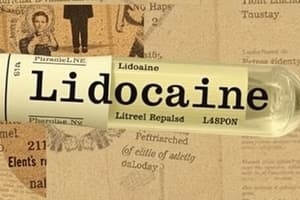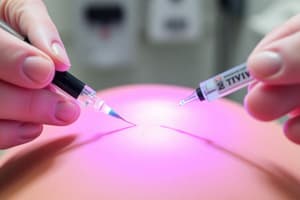Podcast
Questions and Answers
What is the principal use of lidocaine?
What is the principal use of lidocaine?
- As a muscle relaxant
- As a sedative
- As a local and topical anesthetic (correct)
- As an anti-inflammatory agent
Which of the following ailments is lidocaine used to relieve discomfort from?
Which of the following ailments is lidocaine used to relieve discomfort from?
- Sunburn and insect bites (correct)
- Fractures
- Chronic pain syndromes
- Post-surgical pain
Who developed lidocaine and in what year?
Who developed lidocaine and in what year?
- Bengt Lundqvist in 1943
- Bengt Lundqvist in 1949
- Nils Löfgren in 1943 (correct)
- Nils Löfgren in 1949
What is a contraindication for utilizing lidocaine?
What is a contraindication for utilizing lidocaine?
What is the classification of lidocaine?
What is the classification of lidocaine?
Which of the following indicates the potency of lidocaine relative to procaine?
Which of the following indicates the potency of lidocaine relative to procaine?
Which enzyme system is involved in the metabolism of lidocaine?
Which enzyme system is involved in the metabolism of lidocaine?
What year was lidocaine launched for use?
What year was lidocaine launched for use?
Flashcards
Lidocaine
Lidocaine
A tertiary amine antiarrhythmic drug used for local and topical anesthesia.
Local Anesthetic
Local Anesthetic
A medicine that blocks nerve signals, causing numbness in a specific area.
Topical Anesthetic
Topical Anesthetic
A local anesthetic applied to the skin's surface.
Amide local anesthetic
Amide local anesthetic
Signup and view all the flashcards
Lidocaine Hydrochloride
Lidocaine Hydrochloride
Signup and view all the flashcards
Contraindications
Contraindications
Signup and view all the flashcards
Hypersensitivity
Hypersensitivity
Signup and view all the flashcards
Toxicity
Toxicity
Signup and view all the flashcards
Study Notes
Introduction
- Lidocaine is a tertiary amine antiarrhythmic drug primarily used for local and topical anesthesia.
- The first amino amide-type local anesthetic, previously amino esters, was developed by a Swedish scientist.
- It was initially called "xylocaine" and launched in 1949.
Classification
- Lidocaine's potency is 2 compared to procaine (procaine = 1).
- It has a toxicity level of 2 relative to procaine.
- Liver microsomal enzymes metabolize it.
Topical Uses
- Lidocaine reduces discomfort and itching from ailments like sunburns, insect bites, stings, poison ivy, oak, sumac, and minor cuts/scratches.
Injectable Uses
- Xylocaine Dental (lidocaine HCI) provides local anesthesia via nerve blocks or infiltrations for established procedures.
- Only approaches outlined in mainstream textbooks are suggested.
Contraindications
- Lidocaine is contraindicated for those allergic to amide-type local anesthetics.
- It is also contraindicated for patients with Stokes-Adams syndrome, Wolff-Parkinson-White syndrome, or severe degrees of sinoatrial, atrioventricular, or intraventricular blocks.
Studying That Suits You
Use AI to generate personalized quizzes and flashcards to suit your learning preferences.
Related Documents
Description
Explore the diverse applications of Lidocaine, from its historical background to its classification and effective uses in local anesthesia. This quiz will also cover important contraindications to ensure safe usage. Test your knowledge on this essential medical topic.



